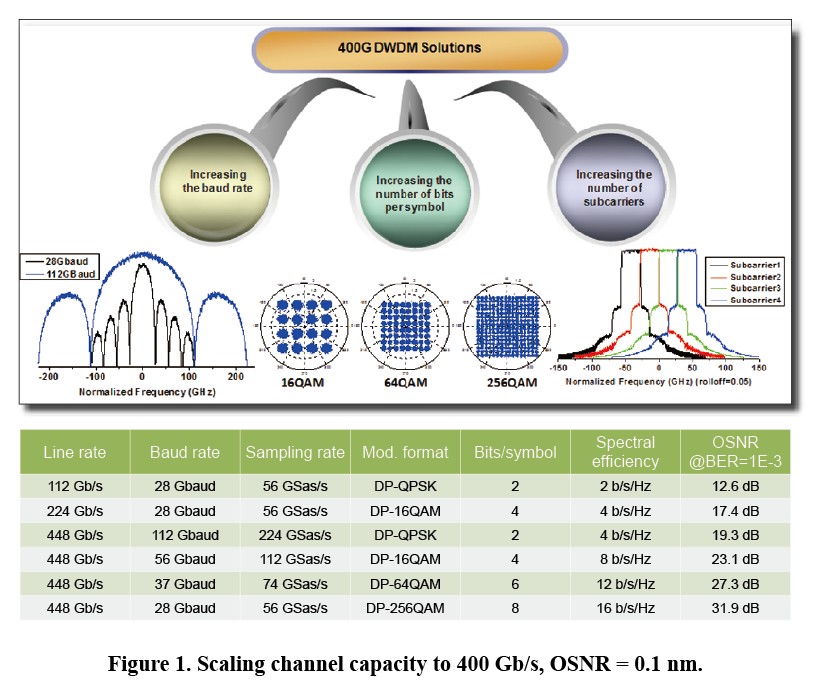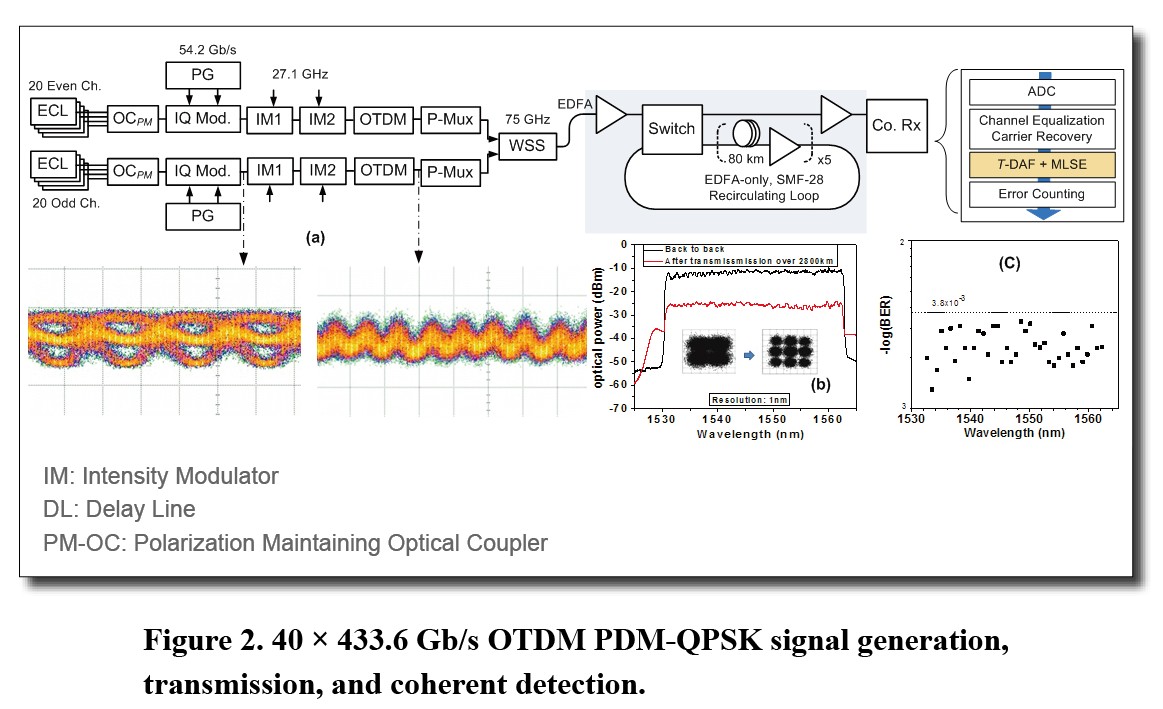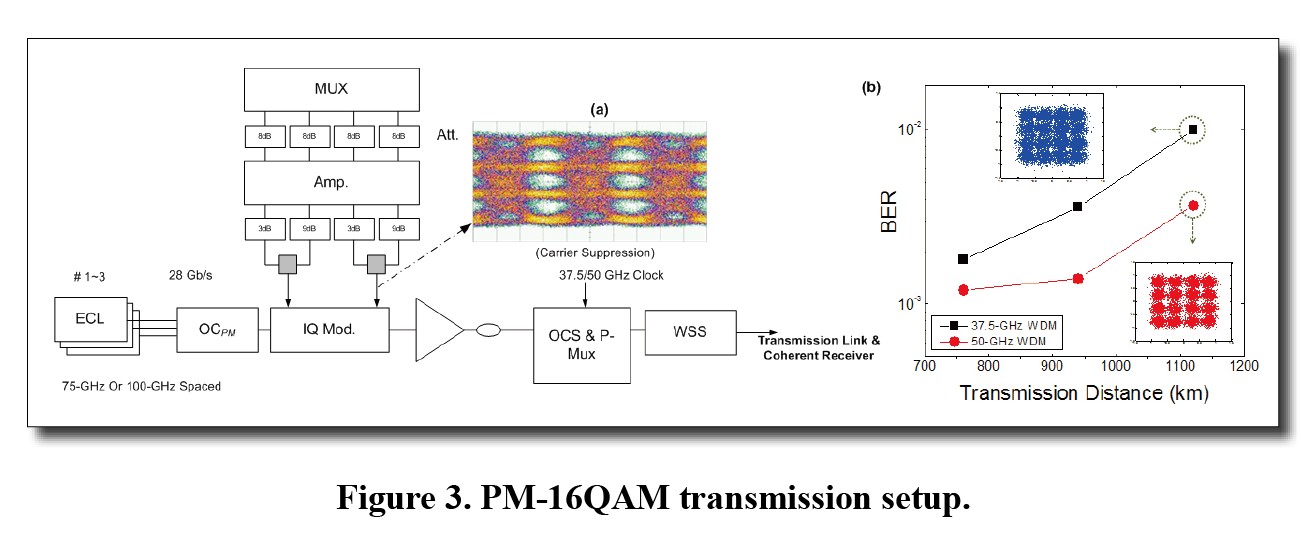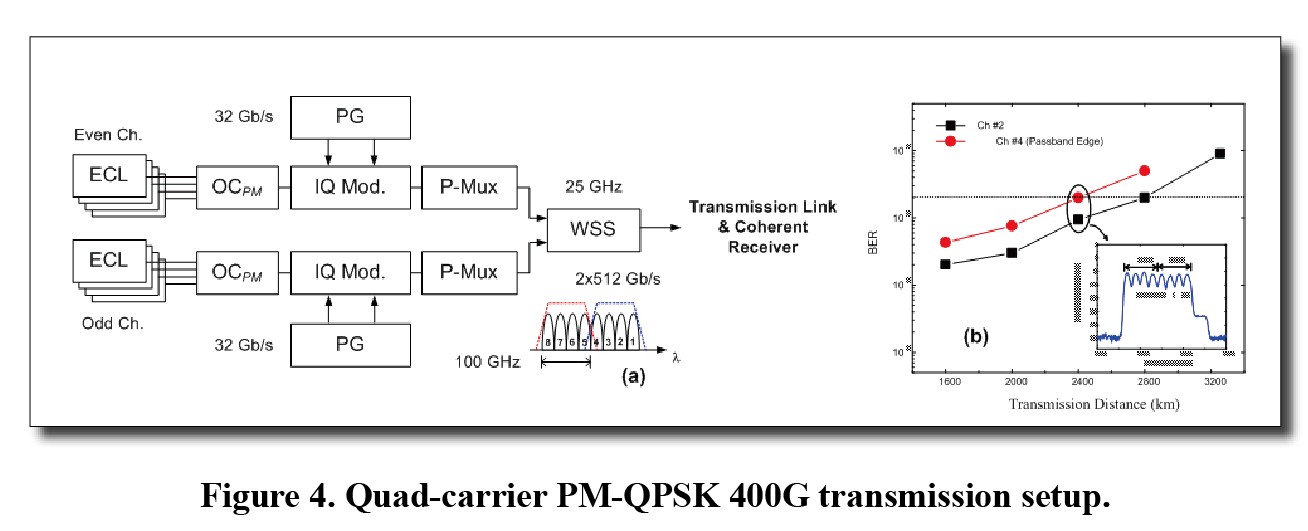400G DWDM: Technologies and Perspectives

Introduction
Network carriers are facing continued demand for bandwidth and capacity in metro, regional, and long-haul networks. Traffic is growing at around 2 dB per year, and this growth is driven by more and more video streaming as well as the proliferation of cloud computing, data centers, social media, and mobile data delivery. Currently, 100 Gb/s optical systems are based on a single-carrier polarization division multiplexed quadrature phase shift keying (PDM-QPSK) modulation format that is associated with coherent detection and digital signal processing (DSP). Such systems have become commercially available and are expected to be widely deployed over the next few years. Optical transport with a per-channel bit rate beyond 100 Gb/s is now in the R&D stage and is designed to sustain traffic growth, improve spectral efficiency, and lower cost per bit in fiber transmission. A data rate of 400 Gb/s per channel is a natural and promising step when we consider both the evolution of datacom and transport interface speed and implementation complexity. Among the many proposed approaches to scaling channel capacity to 400G, there are three main approaches (Fig. 1). The first of these approaches is to continue increasing the signal baud rate from 28 Gbaud to 112 Gbaud by using the same QPSK format. The second of these approaches is to use quadrature amplitude modulation (QAM) formats because they can achieve higher spectral efficiency than PDM-QPSK formats. However, this higher spectral efficiency comes at the expense of greatly reduced transmission distance. To take advantage of existing optoelectronic components and the low optical signal-to-noise ratio (OSNR) requirement of QPSK, multiple optical carrier techniques such as two-subcarrier 16QAM, optical frequency division multiplexing (OFDM), and Nyquist WDM have been proposed for transporting at data rates beyond 100 Gb/s. Here, we review progress on spectrally efficient long-haul optical transmission systems at 400 Gb/s. Taking spectral efficiency and transmission reach as the main benchmarks for optical transmission, we discuss the potential of single and multiple optical-carrier techniques.

Increasing the Baud Rate
Today’s 100 Gb/s commercial systems or 400 Gb/s dual-carrier prototypes are limited to around 30 Gbaud when transporting QPSK signals in coherent detection. To further explore the benefit of QPSK on both transmission distance and spectral efficiency in the system, we generated 40 × 433.6 Gb/s WDM channels at an unprecedented symbol rate of 108.4 Gbaud (which was achieved by OTDM). We successfully transmitted signals over 2800 km SMF-28 with 80 km per span and EDFA-only amplification. Each channel occupies 100 GHz, and this yields a spectral efficiency of 4.05 b/s/Hz. Fig. 2 shows the experimental setup for the generation and transmission of 40 × 433.6 Gb/s OTDM PDM-QPSK signals. The I/Q modulators have 3 dB bandwidth of 32 GHz. They are driven by 54.2 Gb/s PRBS binary signals and are used to simultaneously modulate 54.2 Gbaud QPSK signals on optical carriers. Two cascaded intensity modulators with 3 dB bandwidth of 38 GHz are driven by synchronized 27.1 GHz sinusoidal clock signals. These modulators are used to carve the QPSK signal in order to generate an RZ-QPSK signal with the 3 dB pulse width of approximately 3.5 ps (Fig. 2, inset a). After optical multiplexing and polarization multiplexing, the signals are spectrally filtered, combined, and sent to the transmission link, which consists of five 80 km spans of SMF-28. In the coherent receiver, after 50 GHz balanced detection and polarization/phase diverse hybrid, sampling and digitization (A/D) is performed in the Lecroy commercial digital scope. The scope has four electrical ports of super bandwidth, and each port has a sampling rate of up to 120 GSa/s and 45 GHz electrical bandwidth. As well as the conventional DSP (for channel equalization, timing recovery, and carrier recovery), a post one-bit delay-and-add filter and simplified Viterbi-based maximum likelihood sequence estimation (MLSE) are used to suppress noise and linear crosstalk and to decode the symbols.
The measured optical spectra of 1 nm resolution are shown in Fig. 2 (inset b). The corresponding constellations before and after postfiltering are also shown in Fig. 2 (inset b). The measured BER results are shown in Fig. 2 (inset c). After transmission, the BER for all channels is less than 3.8 × 10-3, which is the hard-decision pre-FEC threshold. These results show the feasibility of creating 400 Gb/s single-carrier channels with PDM-QPSK modulation but without sacrificing transmission distance.

Increasing the Number of Bits per Symbol
Higher-level QAM formats can be used to achieve spectral efficiency that is greater than that of PDM-QPSK, but this comes at the expense of greater implementation complexity, a higher requirement for receiver sensitivity, and reduced optical reach. A dual-carrier approach using 16QAM on 75–100 GHz grid is an attractive solution considering performance requirements and the limitations of existing technology. Here, we investigate 37.5 GHz spacing and 50 GHz spacing, which corresponds 75 GHz and 100 GHz optical occupancy. Three independent lasers with 75 or 100 GHz wavelength spacing are used as the light sources. The generated 4-PAM electrical eye diagram is shown in Fig. 3 (inset a). The optical sources are combined and then IQ-modulated to generate optical 16QAM signals at 112 Gb/s. After being boosted by a PM-EDFA, the signals are divided into two copies by a 50:50 OC. The signals at the lower arm pass through a polarization multiplexer (PMUX) to emulate 224 Gb/s Dp-16QAM optical signals, and those at the upper arm are optically modulated by a 37.5 GHz or 50 GHz clock to generate double optical sidebands with central optical carrier suppression (OCS). After transmission, a fully integrated optical front-end is used to transform the optical field into an electrical field, and then an ADC with digital bandwidth of 20 GHz and sampling rate of 80 GSa/s is used. After DSP, the measured BER is as shown in Fig. 3 (inset b) for given transmission distances of 760, 940, and 1120 km and 37.5 and 50 GHz channel spacing. Below the limit of 3.8 × 10-3, 37.5 GHz WDM is potentially capable of 950 km transmission. The 50 GHz WDM performs better and is capable of 1130 km transmission.

Increasing the Number of Carriers
Using Nyquist WDM or OFDM to pack together a number of established PM-QPSK channels is another practical way of achieving 400G transmission. Theoretical and experimental comparisons show that Nyquist WDM is much more tolerant of intercarrier interference (ICI) and has less implementation constraints. In Nyquist WDM, the subcarriers are spectrally shaped so that their occupancy is close to or equal to the Nyquist limit. In this implementation, the optical multiplexer with narrowband filtering performs aggressive spectrum shaping and multiplexing to obtain Nyquist spacing. However, in the intra- and interchannels, crosstalk induced by spectral shaping greatly limits transmission performance. The idea previously proposed for the digital filter and simplified MLSE algorithm can also be employed in a multicarrier scheme for 400G channels. Here, we experimentally demonstrate a 400G generation and transmission solution based on quad-carrier PM-QPSK at a total channel line rate of 512 Gb/s. The channel-spacing-to-symbol-rate ratio can be brought down to only 0.78, which yields a net SE of 4 b/s/Hz. Fig. 4 shows the experimental setup for 400G transmission based on quad-carrier PM-QPSK at 4 b/s/Hz. This contains a 100 GHz inline wavelength-selective switch (WSS) in recirculating loop in order to determine the maximum transmission distance and the highest number of ROADMs that can be potentially achieved and passed. We use 8 external cavity lasers (ECLs) as a CW light source array and group them into even and odd channels spaced at 25 GHz. Assuming there is soft-decision FEC and protocol overheads, all the PM-QPSK channels at 128 Gb/s are aggressively shaped in the spectrum domain and simultaneously combined using a 25 GHz WSS. In the end, there were 8 × 128 Gb/s channels generated on a 25 GHz grid. This can be viewed as two independent 400G (512 Gb/s quad-carrier PM-QPSK) channels (Fig. 4, inset a).
Fig. 4 (inset b) shows the received optical spectrum after 2400 km transmission with 20.4 dB delivered OSNR. The results show that 400G transmission using quad-carrier PM-QPSK is possible over at least 2400 km on a 100 GHz grid, and the net spectral efficiency of 4 b/s/Hz.

Summary
100G per channel is already established in the transport market, and 400G is the next logical step to handle an ever-increasing amount of data traffic. ZTE is leading the industry in 400G R&D and has explored a number of schemes for potential use at 400G per channel transmission link. There are multiple approaches for scaling channel capacity beyond 100G over metro and long-haul distances. Dual carrier DP-16QAM, which is currently favored by the optical industry, has a meaningful transmission reach for regional and metro applications. However, further investigations are needed to fully understand the potential for long-haul DWDM systems. Solutions based on DP-QPSK can improve spectral efficiency without sacrificing transmission distance, which means that long-haul distances are still reachable at the expense of either higher bandwidth requirement for transmitter and receiver components or increased density of parallel integration. Any adopted approach must not only have high SE and receiver sensitivity but also be implementable using cost-efficient technologies and components. As the whole industry moves towards next-generation transmission speeds, standards organizations must work together, as was the case with 100G optical interfaces. We should learn from 40G mistakes in order to avoid falling into the same traps.